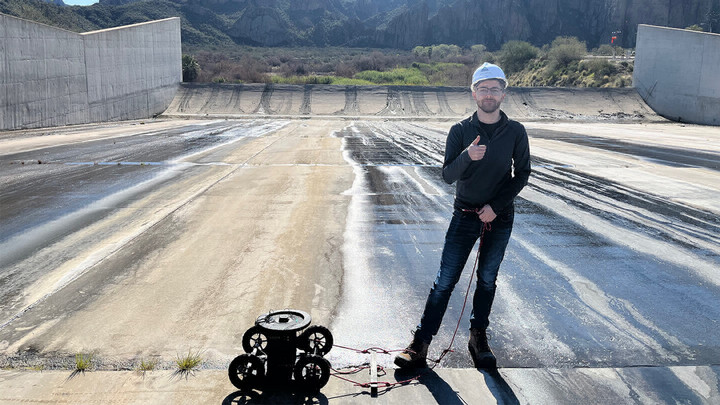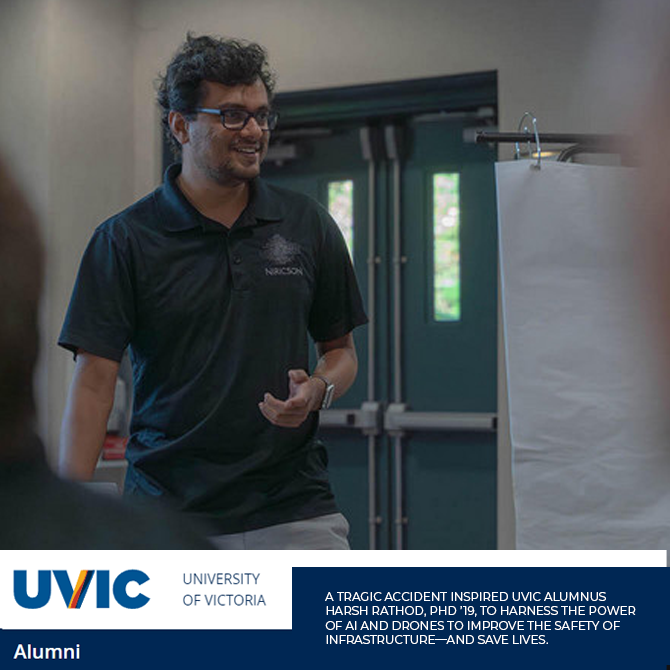Read the full article here
A tragic accident inspired UVic alumnus Harsh Rathod, PhD ’19, to harness the power of AI and drones to improve the safety of infrastructure—and save lives.
In 2016, Harsh Rathod was in the middle of his PhD in civil engineering at the University of Victoria and scrolling through news headlines on his phone. He noticed a media report that made him gasp: a bridge on the bustling Mumbai-Goa highway that some of his family members often used had collapsed, killing almost 30 people. Rathod called his family, found out they were safe, but the disaster still nagged at him, like an ache that wouldn’t go away.
His doctoral work leaned into using robotics and computer vision (a field of AI) to assess the condition of dams, bridges and other forms of infrastructure. He began to realize it wasn’t a far-fetched idea to do something about the structural degradation of those sites—and to launch a company layering innovative tech to make it easier to do so.
In January 2020, after earning his PhD in 2019, he co-founded Victoria-based Niricson with Aki Tomika, CTO, who brought years of experience in the tech industry. The name Niricson comes from the Sanskrit word nireekshan, which means “inspection” or “detailed investigation.” The company leverages drones and AI to assess bridges, airport runways and hydro dams. The team has tested infrastructure at various sites, including Toronto’s Pearson International Airport, Southern Saskatchewan’s Gardiner Dam and Australia’s Cataract Dam. Niricson, a company of 50 people, currently has clients in Canada, US, UK, Australia and New Zealand.
Sound Information
Civil engineers and inspectors were still using some old-fashioned methods to analyze if a massive asset like a bridge is compromised—so the Niricson team sought to improve on those. “Believe it or not, they still use a pen and paper and hammer—to tap the concrete to find out if it’s hollow,” says Rathod, who is CEO of Niricson. “And X-rays may be used as well, but that’s very rare, perhaps less than one per cent of all inspections.”
Focusing on a data-driven approach, Niricson collaborates with drone companies to set up a program for clients where site information can be ingested through Niricson’s proprietary platform—AUTOSPEXTM. Those drone flyovers can offer valuable data to the client on an asset’s status beyond what a manual inspection can accomplish. The key is that the drones don’t just harness visual capabilities, but they can also assess a site with thermal and acoustic technology (known as DRONICTM).
The thermal technology software dives up to 50 mm into the subsurface of the concrete, and acoustic tests can process even more data by going up to 200 mm into the structure. “Combine those three layers and we feature a shared intelligence report that can share any deficiencies and how deteriorations over time have progressed,” Rathod says.
The drones’ cameras can identify falling concrete chunks, vegetation, salt deposits and rust stains that signal potential damage. The thermal technology analyzes any temperature differences. A hollow area within concrete may present with a big red or blue spot, depending if the temperature has risen very high or low. The thermal feature of Niricson’s AUTOSPEXTM software can also look for any moisture/leakage, which is extremely difficult to do by sight.

The acoustic side of a drone flyover will include the gadget holding a hammer that engineers still employ, and the system collects “sounding and vibration data” to better understand how the concrete vibrates and if it’s still sound concrete. Using audio technology, the drone can “hear” if the concrete is hollow. “The manual method of doing this is very challenging, no matter how fine tuned someone’s ears may be,” he says.
For the Toronto Pearson airport contract in 2022, Rathod and his team spent hours on the runway with drones to compile a detailed 3D model of the 60,400 square-metre asset along with quantified defect maps. Being able to accurately scan this runway served as a litmus test for Niricson, which has since gone on to analyze runways in Montreal and Vancouver.
Rathod, who lives in Vancouver, says their system takes advantages of AI tech and computer vision “teaching the machine to recognize patterns in things like cracking, spalling, slab offset and honeycombing etc., which totals around nine million data sets at the moment.”
In August 2023, Niricson secured over $10 million in Series A financing led by MUUS Climate Partners. That kind of funding, the first raised by outside investors, will go towards “product development and the ability to take on more projects,” Rathod says.
A natural innovator
Raised in Gujarat, India, Rathod always felt he was different growing up. “I hated doing the same thing everyone else was doing. I could feel like I thought outside the box, so to speak,” he recalls. Being an entrepreneur was a natural choice for Rathod. His father and four brothers started their own company from the ground up, running a business that supplied auto parts to the Indian army.
After graduating with civil engineering degrees from Nirma University, Rathod considered Canadian universities for his doctoral work over American equivalents because he perceived the immigration process and Vvisa requirements to be more favourable in Canada. At UVic, he soon realized how fortunate he was to move to Canada.
“Here, the opportunities are endless, and I found that people are so nice, and that they are more than happy to help you and support you and your vision.”
While still a student, Rathod took his idea for Niricson and presented its business model to the semi-annual PlanIt competition, run by UVic’s Coast Capital Innovation Centre. His short presentation earned him a win for the business plan and $5,000. After Niricson was awarded $19,000 from a larger start-up competition prize at the University of Washington, the team was ready for the spotlight. They approached BC Hydro to discuss assessing their dams with drone and AI technology. BC Hydro became Niricson’s first and most loyal client.
Rathod’s start-up is part of an asset-assessment sector that is evolving at a vital time. The 2019 Canadian Infrastructure Report showed that the state of the nation’s infrastructure is at risk. For example, findings showed that almost 40 per cent of roads and bridges are in fair or worse condition and only 20 per cent of the assets were constructed in the last 20 years. Engineering specialists in Canada also recognize the potential impact of climate change to infrastructure.
Rathod is adept at communicating with clients who have concerns about their assets and ask him how Niricson will offer a superior approach to surveying concrete for leaks and cracks. “I can speak engineer to engineer, so in that way, talking to customers came easily to me,” he says, adding how he’s thankful for the business acumen of co-founder Aki Tomita.
What Rathod finds fulfilling about blazing a trail in damage-assessment software comes down to the final outcome. “When we find deficiencies and we can see how our clients react to finding out that, say, they have a serious issue with a concrete chunk about to fall apart, that is a huge boost for me. And that joy, that motivation, is transferred down to our team and they are just as pumped up as I am to align with our mission to save people’s lives.”
—David Silverberg

